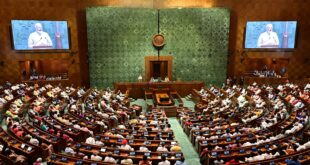
Dr. Seema Javed
Delhi , Hariyana and Chandigarh have touched 50 degrees Celsius temperatures during day time. As a large part of India sizzle with unliveable heat. The climate crisis caused by climate change has caused boiling temperatures making life unbearable not only for humans but also for animals.

Climate change refers to long-term shifts in temperatures and weather patterns. Such shifts can be natural, due to changes in the sun’s activity or large volcanic eruptions. But since the 1800s, human activities have been the main driver of climate change, primarily due to the burning of fossil fuels like coal, oil and gas.
On 24 May, IMD issued a warning that heatwave to severe heatwave conditions will prevail in many parts of Rajasthan, Vidarbha-Madhya Pradesh, some parts of Punjab, Haryana, Chandigarh, West Uttar Pradesh, and Delhi during 24-27 May.
‘Right now it’s seriously beyond the threshold of human survivability – even for those of us who’ve grown up iin northern and north western India.India has so far recorded 60 heat-related deaths since 1st of march.32 people have died due to heatstroke and 28 from suspected heatstroke, with the latest two suspected deaths reported in Andhra Pradesh and Rajasthan’s Kota on 22 May, government data showed.Meanwhile, the country has seen 16,344 suspected heat stroke cases since 1 March this year, with 486 suspected heat stroke cases on 22 May alone.
India is projecting its biggest power shortfall in 14 years in June after a slump in hydropower generation, its government told Reuters, and is racing to avoid outages by deferring planned plant maintenance and re-opening idled units.
50C (122Fz) is half way to boiling temperature at which human cells start to cook and animals suffer.You really could fry an egg on the pavement. A dog’s paws would blister on a short walk. In the hottest hours of the day, working outdoors is banned. The only people in sight are those who do not have access to air conditioning, who have no escape from t heat: the poor, the homeless, labourers Construction workers, auto rickshaw fellows , street vendors selling vegetables and fruits and street hawkers cover up head to toe to stay cool.
Society is divided into the cool haves and the hot have-nots.Those without the option of sheltering indoors can rely only on shade. motor-rickshaw drivers The wealthy, meanwhile, go from one climate-conditioned environment to another: homes, cars, offices, gymnasiums, malls.This is the present heatwave scenario across the northern and central parts of India.
The IPCC fifth assessment report on climate science found evidence for climate change is unequivocal. The impacts of increasing frequency and intensity of extreme weather events on people and our environment are real and undeniable. In addition to a steady increase in mean temperature, climate also affects animals via the increasing severity and frequency of extreme events such as heat waves.Heat extremes, increasing average temperatures will slowly but inexorably push species up mountain sides where they will eventually run out of room and shelter.
 Jubilee Post News & Views
Jubilee Post News & Views





